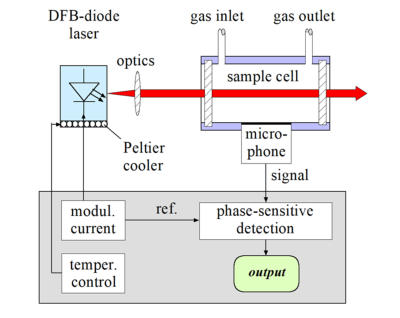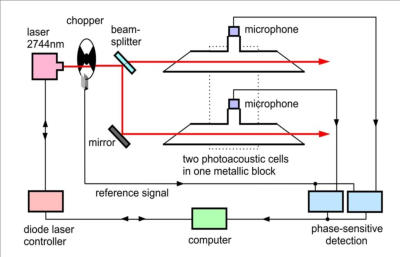
f) Photo-Acoustic Sensors for Environmental and Medical Applications
An increasing number of environmental problems has initiated the development of sensitive detectors for monitoring pollutants in the atmosphere. Particularly sensors based on the photo- acoustic effect in conjunction with lasers have the potential of monitoring trace gases at con- centrations down to the ppt (parts per trillion) region. Also in medical diagnostics photo-acoustic sensors find successful applications as breath test analyzer.Photo-Acoustic Effect
Photo-acoustic detection utilizes the fact, that the excitation energy of light absorbing molecules is essentially transferred into kinetic energy of the surrounding molecules via inelastic collisions. This causes a local pressure increase in the absorbing gas. If the excitation source is modulated, a sound wave is generated, that can be detected by a mi- crophone. This signal is di- rectly proportional to the concentration of the absorb- ing molecules in the sample. Therefore a calibrated set-up allows to measure directly the absolute concentration of a gas. Photo-acoustic spectroscopy (PAS) has the advantage of producing a signal only when light is absorbed. Hence, contrary to transmission spectroscopy, PAS is an offset-free technique, and it is possible to replace relatively long absorption cells by much smaller ones. In addition, acoustic cell resonances can successfully be used to further enhance the signal and there- by to further increase the detection sensitivity. The PAS technique is primarily used in con- junction with high power gas lasers, since the photo-acoustic signal is proportional to the intensity of the light. However, the disadvan- tage of these lasers is often their non-tunabi- lity and therefore the requirement of a coin- cidence with an absorption line. Usually, the modulation of these lasers is performed with a mechanical chopper, which may cause coher- ence noise by the rotating blade and an additional photo-acoustic signal by absorption of the cell windows. This deteriorates the sensitivity of a photo-acoustic detector. Most of these disadvantages can be avoided by a photo-acoustic spectrometer, which is based on a single frequency diode laser for the selective excitation of the trace gases. In the meantime the available emission wavelength of these lasers covers the entire near IR and mid IR spectral range which is important for trace gas detection, since most molecules have their strong fundamental vibration absorption bands in this region.Detection of Toxic Industrial Gases
An example for high selective and sensible detection of a toxic gas is a photo-acoustic sensor for hydrofluoric acid (HF). This gas is widely used in industrial processes as a chemical intermediary for purification, cleaning, and synthesis. It is also released to the atmosphere at garbage incinerators, at power plants or in the metal and chemical industry. Since HF is highly toxic, already smallest concentrations must be monitored to register any leakage in a gas pipe system or closed compartment and to give alarm at dangerous concentration levels. HF has a Threshold Limit Value of 3 ppm (by volume) and is generally measured with relatively expensive sensors like chromatographs, ion mobility spectrometers or electro-chemical cells. A sensor based on a room temperature distributed feed¬back (DFB) diode laser operating on a wavelength of 2.476 μm in combination with a photo-acoustic resonance cell represents a much cheaper, more compact and much more sensitive detector allowing measurements of HF con- centrations of a few ppb.13
C-Breath-Test-Analyzer
Medical breath tests are well established diagnostic tools, predominantly for gastroenterological in-spections, but also for many other examinations. Since the composition and concentration of exhaled volatile gases reflect the physical condition of a patient, a breath analysis al- lows to recognize an infectious disease in an organ or even to identify a tumor. One of the most prominent breath tests is the 13 C-urea-breath test, applied to ascer- tain the presence of the bacterium helico- bacter pylori in the stomach wall as an indi- cation of a gastric ulcer. For such a breath test a patient orally re- ceives isotope-marked urea, where the most common isotope 12 C is replaced to a large extent by the isotope 13 C (natural abundance is 1.1 %). In the stomach the substrate is metabolized to isotope marked carbon dioxide which in the presence of helicobacter bacteria is absorbed by the blood and finally released in the patient’s breath. For a reliable diagnosis already changes of the 13 CO 2 concentration of 1% have to be detected at a concentration level of this isotope in the breath of about 400 ppm. The total CO 2 concentration in the exhaled breath is about 4%. Generally this concentration is determined by a highly sophisticated and expensive gas analy- zer like a differential mass spectrometer or a specially adapted optical gas detector. An at- tractive and relative cheap alternative is a photo-acoustic analyzer operating with an am- plitude modulated semiconductor laser on a wavelength of 2.744 µm. The concentration ratio of the CO 2 isotopo- logues is determined by measuring the integral absorption over a 13 CO 2 line in comparison to a 12 CO 2 line. In a specially selected spectral range the lines have similar strengths, although the concentrations differ by a factor of 90. Therefore, the signals are well comparable. The laser wavelength is accurately controlled and tuned across the absorption lines by changing the laser temperature. Since it is much easier to monitor any variations of the isotopic abundance with respect to a reference than to detect an absolute concentration, the laser radiation is split into two beams which then pass through two identical photo-acoustic cells containing different breath samples, one taken before (used as reference) and one after capturing the isotope-marked substrate. Such a set-up gives excellent signal-to- noise ratios and allows to resolve isotopic concentration differences of 1‰ or even less, which is quite sufficient for a reliable breath test analysis.Doctoral Theses
L. Pfeifer Photoakustische Untersuchungen am TNT in der Dampfphase School of Electrical Engineering, Helmut-Schmidt-Uiversity, Hamburg 1992 M. Wolff Photoakustischer Nachweis von Spurengasen - Realisierung kompakter Gassensoren School of Electrical Engineering, Helmut-Schmidt-Uiversity, Hamburg 1997 M. Germer Photoakustischer Stickstoffmonoxid-Detektor auf Basis eines QuantenkaskadenlasersSchool of Electrical Engineering, Helmut-Schmidt-Uiversity, Hamburg 2010
Refereed Publications in Journals and Conference Digests
M. Wolff, H. Harde Photoacoustic Spectroscopy with a Frequency-Modulated DFB Diode Laser Conference on Lasers and Electro-Optics, Vol. 11, 1997 OSA Technical Digest Series (Optical Society of America), Washington, D.C.,1997, p. 518 (1997) M. Wolff, H. Harde Photoacoustic Spectrometer Based on a DFB-Diode Laser Infrared Physics and Technology, 41 (5), pp. 283-286 (2000) M. Wolff, H. Harde Photoacoustic Spectrometer Based on a Planckian Radiator with Fast Time Response Infrared Physics and Technology 44, pp. 51-55 (2003) M. Wolff, H. Harde, H. Groninga Photoacoustic Sensor for Medical Applications Photonics East – Smart Medical and Biomedical Sensor Technology and Applications, Providence/RI, Proceedings of SPIE, Vol. 5261, pp. 5261–09 (2003) M. Wolff, H. Groninga, H. Harde Photoakustischer Sensor für Medizinische Diagnostik Innovationsforum Photonik, Tagungsband, Goslar (2003) M. Wolff, H.G. Groninga, H. Harde, Photoacoustic Distributed Feedback Laser Spectroscopy on Hydrogen Fluoride, Appl. Spectrosc., 58 (6), pp. 552-554 (2004) M. Wolff, H. Harde, H.G. Groninga Isotope-Selective Sensor based on PAS for Medical Diagnostics 13th International Conference on Photoacoustic and Photothermal Phenomena (ICPPP), 13P-15, Rio de Janeiro/Brazil (2004) M. Wolff, H. Groninga, H. Harde Photoacoustic Sensor for Medical Diagnostics Conference Digest of Conference on Bio-Medical Optics 2004, Rio de Janeiro (2004) M. Wolff, H.G. Groninga, M. Dressler, H. Harde Photoacoustic Sensor for VOC’s: First Step towards a Lung Cancer Breath Test European Conference on Biomedical Optics (ECBO), Munich/Germany, 12.-16. September 2005, pp. 110-112 (2005) M. Wolff, H.G. Groninga, M. Dressler, H. Harde Photoacoustic Sensor for VOC’s: First Step towards a Lung Cancer Breath Test Proc. SPIE, Vol. 5862, pp. 5862-16 (2005) M. Wolff, H.G. Groninga, H. Harde Resonance Investigations using a Photoacoustic Multi-Microphone System Gordon Research Conference on Photoacoustic & Photothermal Phenomena (GRC PPP), A26, Trieste/Italy (2005) M. Wolff, H. Groninga, H. Harde, B. Baumann, B. Kost Resonance Investigations using PAS and FEM Forum Acusticum, Budapest, FA-7760 (2005) M. Wolff, H. Groninga, B. Baumann, B. Kost, H. Harde Resonance Investigations using PAS and FEM Acta Acustica, Vol. 91, Suppl. 1, 99 (2005) M. Wolff, H. Harde, H.G. Groninga Isotope-Selective Sensor Based on PAS for Medical Diagnostics J. Phys. IV France, 125, 773-775 (2005) M. Wolff, H. Groninga, H. Harde Photoacoustic CO 2 Detection at 2.7 μm Photonics Europe – Optical Sensing II, Strasburg, 5. April 2006, Proceedings of SPIE, Vol. 6189, pp. 220-225 (2006) M. Wolff, H.G. Groninga, H. Harde Isotope-Selective CO2 Detection at 2.7 µm Proceedings of the 9th International Conference on Infrared Sensors & Systems Nürnberg (2006) H. Harde, J. Pfuhl, M. Wolff, H. Groninga MolExplorer: A New Tool for Computation and Display of Spectra from the HITRAN Database Ninth HITRAN Conference, Harvard University, Cambridge MA, USA, 25.-28. Juni 2006 http://cfa-www.harvard.edu/hitran/HITRAN_conf06_presentations/Session5/5.5-Harde.pdf M. Wolff, M. Germer, H. Groninga, H. Harde Photo-Acoustic CO 2 Sensor based on a DFB Diode Laser at 2.7 µm 14th International Conference on Photoacoustic and Photothermal Phenomena (ICPPP), P12.2, 185, Cairo/Egypt, Technical Digest and Journal de Physique IV (2007) M. Wolff, M. Germer, H.G. Groninga, H. Harde Photo-Acoustic CO 2 Sensor based on a DFB Diode Laser at 2.7 µm Eur. Phys. J. Special Topics, Vol. 153 (1), 409-413 (2008) H. Harde, M. Dressler, G. Helmrich, M. Wolff, H. Groninga New Optical Analyzer for 13 C-Breath Test Proc. SPIE 6991, Biophotonics: Photonic Solutions for Better Health Care, 69910T (2 May 2008); Strasburg, France, doi: 10.1117/12.781271; https://doi.org/10.1117/12.781271 M. Dressler, G. Helmrich, Hermann Harde Photoacoustic HF-Sensor Proc. SPIE 7003, Optical Sensors 2008, Strasburg, 70031F (28 April 2008); doi: 10.1117/12.781679 (2008) H. Harde, G. Helmrich, M. Wolff Opto-Acoustic 13 C-Breath Test Analyzer BiOS, Proc. SPIE 7564, Photons Plus Ultrasound: Imaging and Sensing 2010, 75641E (24 Feb. 2010), San Francisco, https://doi.org/10.1117/12.841660Contributions on National Conferences and Meetings
L. Pfeifer, H. Harde Photoakustische Untersuchungen an Explosivstoffen in der Dampfphase Frühjahrstagung der Deutschen Physikalischen Gesellschaft, Fachausschuss Kurzzeitphysik, Hannover, 27. März 1992, Verhandl. DPG (VI) 27, K 10.2, 1278 (1992) M. Wolff, U. Selbach, H. Harde Isotopenselektiver Nachweis von CO 2 für medizinische Anwendungen mit Hilfe der photoakustischen Spektroskopie Poster Lasertag 1992, Hannover, 2. Dezember 1992 M. Wolff, U. Selbach, H. Harde Isotopenselektiver Nachweis von CO 2 für medizinische Anwendungen mit Hilfe der photoakustischen Spektroskopie Frühjahrstagung der Deutschen Physikalischen Gesellschaft, Arbeitsgemeinschaft Quantenoptik, Berlin, 17. März 1993, Verhandl. DPG (VI) 28, Q 31.5, 429 (1993) M. Wolff, H. Harde Photoakustische Spektroskopie am HF mit Hilfe eines Halbleiterlasers Poster Lasertag 1995, Hannover, 6. Dezember 1995 M. Wolff, H. Harde Spektroskopische Untersuchungen an der ersten Oberschwingung von HF Frühjahrstagung der DPG, Sektion Quantenoptik, Jena, 14. März 1996, Verhandl. DPG (VI) 31, Q 28.3, 255 (1996) M. Wolff, H. Harde Photoakustischer Sensor für Halogen-Wasserstoffe Poster Lasertag 1996, Hannover, 11. Dezember 1996 M. Wolff, H. Harde Photoakustische Spektoskopie mit Hilfe einer frequenzmodulierten DFB-Laserdiode Frühjahrstagung der DPG, Arbeitsgemeinschaft Quantenoptik, Mainz, 3. März 1997, Verhandl. DPG (VI) 32, Q 12.7, 318 (1997) M. Dreßler, M. Wolff, H. Groninga, H. Harde Photoakustischer Sensor für medizinische Anwendungen 2. Hamburger Studententag zur Medizin- u. Biotechnologie 2005 M. Germer, M. Wolff, H.G. Groninga, H. Harde Photoakustische NO-Detektion mittels gepulstem Quantenkaskadenlaser Frühjahrstagung der Deutschen Physikalischen Gesellschaft, Sektion Quantenoptik, Verhandl. (DPG) (VI) 43, Q-Laser (2008)Patents
M. Wolff, H. Harde, Vorrichtung und Verfahren zur Messung der Konzentration eines Gases in einem Gasgemisch, DE 44 46 723 (1994) M. Wolff, H. Harde, Gasdetektor zur Messung der Konzentration eines Gases in einem Gasgemisch, DE 196 38 761 (1996) M. Wolff, H. Harde, H. Groninga, Verfahren zur Messung von Gaskonzentrationen oder dem Verhältnis von Gaskonzentrationen mit potentiellen Anwendungen in der Atem-Analyse, DE 103 08 409 (2003)
Physics & Climate



















